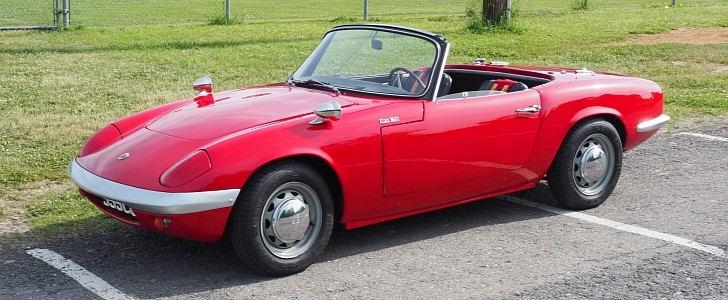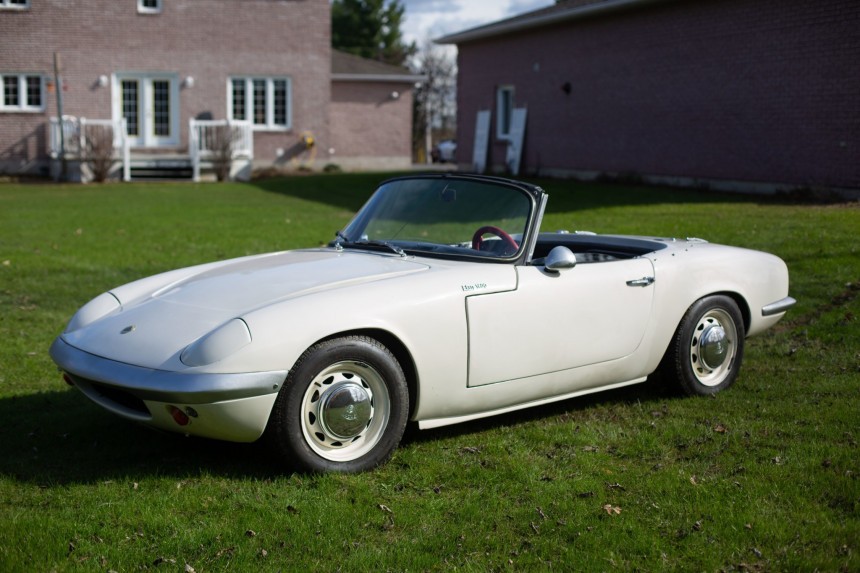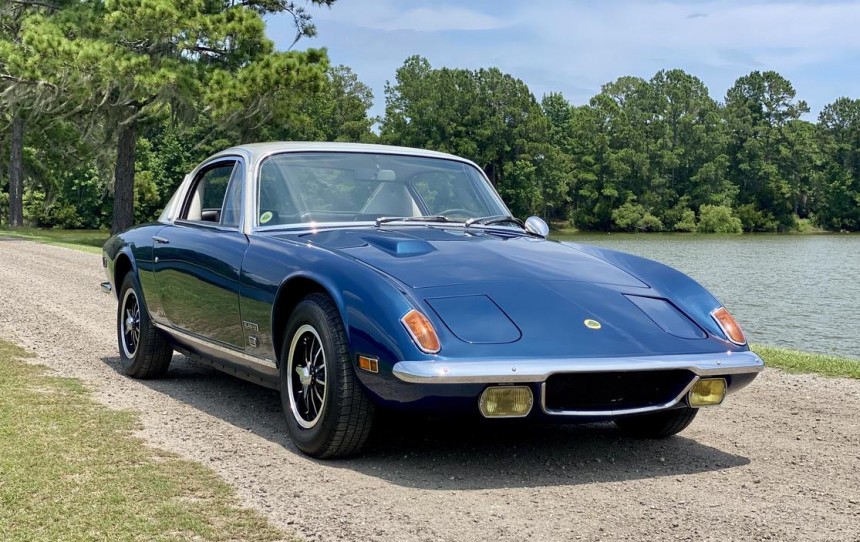Designed by Colin Chapman, the Lotus Mark I from 1948 paved the way for the open-top Seven that embodies the British automaker’s philosophy. Stupidly fun in the twisties though it may be, the road-legal clubman racer can hardly be considered a true automobile over a few reasons, chief among which is the lack of doors. Chapman, however, knew that his plucky company wouldn’t survive without a proper street-going car.
Lotus delivered the ultra-collectible Type 14 Elite in 1957, the year they also premiered the Seven. Introduced at the British Motor Show at Earls Court, the coupe-bodied Elite didn’t sell particularly well. Just over 1,000 units were produced through 1963, and Chapman lost money on every single one of them due to particularly costly bits and pieces. These include the GRP monocoque, glass-reinforced plastic for the load-bearing structure, the all-alloy Coventry Climax FWE four-pot engine, and independent suspension.
Staying true to the philosophy that shaped Lotus into a world-famous F1 outfit and sports car maker, Chapman decided to simplify its next car as much as possible. Designated Type 26, the gorgeous Elan premiered at Earls Court in October 1962 to positive critical reception. As opposed to its predecessor, this fellow is rocking a steel chassis that weighs 40 kilograms (88 pounds).
Double-wishbone front independent suspension with Triumph uprights also need to be mentioned, along with Chapman struts with a single wishbone for the rear axle. Outboard and partially inboard Girling disc brakes are featured as well, along with 13-inch steelies mounted with Goodyear tires.
As far as the body is concerned, Lotus decided on glass-reinforced plastic once again. The Ron Hickman-penned Elan further sweetens the deal with vacuum-operated retractable headlights, very short overhangs, and cutesy wraparound bumpers. A 45.5L tank quenches the thirst of the four-cylinder engine up front, a 1.5L four-pot developed by Lotus around an iron block.
Based on the Kent 116E pushrod engine, the Lotus-Ford Twin Cam is named as such because Chapman’s team improved the original design with a DOHC cylinder head constructed from aluminum. Just over 20 cars were produced with the 1,499-cc version of this engine, which cranks out in the ballpark of 100 horsepower. All of them were subsequently called back to the Lotus Cheshunt factory to receive the slightly pokier 1.6-liter Twin Cam engine.
The British automaker increased the bore from 81 to 82.57 millimeters, resulting in a displacement of 1,558 cubic centimeters. Fed by twin-choke side-draft carburetors, this lump cranks out 105 ponies and 108 pound-feet (146 Nm) of torque at 4,000 revolutions per minute. All Elans were fitted with a four-speed manual gearbox featuring an all-synchromesh system and an aluminum bellhousing that’s noticeably lighter than a steel one.
Speaking of weight, can you believe the Lotus Elan weighs only 585 kilograms or 1,290 pounds? That’s exceptionally light even by Mazda MX-5 Miata standards, and coincidentally, the British icon served as inspiration for the world’s best-selling roadster. The Caterham Seven 170 for the 2022 model year, by comparison, tips the scales at 440 kilograms (970 pounds).
As you’d expect of a bonafide sports car from the 1960s, the heater and radio were optional. A tonneau cover was listed on the options list as well, together with a hardtop, a close-ratio tranny, an oil cooler, and better tires.
Continuously improved through 1973 when the final example rolled off the assembly line, the two-seat Elan totals just over 12,200 units, yet true production figures aren’t known due to bad record keeping. Production is split between 7,895 units of the S1 through S3 variants, 2,976 units of the S4, and 1,353 copies of the Sprint as per John Bolster’s book on the Elan and Europa.
The considerably heavier Elan +2 continued production until 1975. A two-door coupe with rear seats that are only suitable for small kids, the family-hauling sports car is believed to have numbered as many as 5,200 copies. John Bolster, on the other hand, says that only 3,300 were manufactured.
Lotus revived the Elan with the help of General Motors in 1989, although the front-wheel-drive M100 couldn’t have arrived at a worse time. 1989 also marks the first year for the rear-drive Miata. Somewhat baffling, the Japanese roadster that copied the original Elan was much better in every respect than this poor excuse of an Elan powered by an Isuzu four-potter.
The concept unveiled at the 2010 Paris Motor Show marks the very end of the Lotus Elan story. Originally anticipated to enter series production by 2013 with a 4.0-liter V6, the midship sports car was unfortunately axed along with four other concept cars due to increasing financial difficulties.
Staying true to the philosophy that shaped Lotus into a world-famous F1 outfit and sports car maker, Chapman decided to simplify its next car as much as possible. Designated Type 26, the gorgeous Elan premiered at Earls Court in October 1962 to positive critical reception. As opposed to its predecessor, this fellow is rocking a steel chassis that weighs 40 kilograms (88 pounds).
Double-wishbone front independent suspension with Triumph uprights also need to be mentioned, along with Chapman struts with a single wishbone for the rear axle. Outboard and partially inboard Girling disc brakes are featured as well, along with 13-inch steelies mounted with Goodyear tires.
As far as the body is concerned, Lotus decided on glass-reinforced plastic once again. The Ron Hickman-penned Elan further sweetens the deal with vacuum-operated retractable headlights, very short overhangs, and cutesy wraparound bumpers. A 45.5L tank quenches the thirst of the four-cylinder engine up front, a 1.5L four-pot developed by Lotus around an iron block.
The British automaker increased the bore from 81 to 82.57 millimeters, resulting in a displacement of 1,558 cubic centimeters. Fed by twin-choke side-draft carburetors, this lump cranks out 105 ponies and 108 pound-feet (146 Nm) of torque at 4,000 revolutions per minute. All Elans were fitted with a four-speed manual gearbox featuring an all-synchromesh system and an aluminum bellhousing that’s noticeably lighter than a steel one.
Speaking of weight, can you believe the Lotus Elan weighs only 585 kilograms or 1,290 pounds? That’s exceptionally light even by Mazda MX-5 Miata standards, and coincidentally, the British icon served as inspiration for the world’s best-selling roadster. The Caterham Seven 170 for the 2022 model year, by comparison, tips the scales at 440 kilograms (970 pounds).
As you’d expect of a bonafide sports car from the 1960s, the heater and radio were optional. A tonneau cover was listed on the options list as well, together with a hardtop, a close-ratio tranny, an oil cooler, and better tires.
The considerably heavier Elan +2 continued production until 1975. A two-door coupe with rear seats that are only suitable for small kids, the family-hauling sports car is believed to have numbered as many as 5,200 copies. John Bolster, on the other hand, says that only 3,300 were manufactured.
Lotus revived the Elan with the help of General Motors in 1989, although the front-wheel-drive M100 couldn’t have arrived at a worse time. 1989 also marks the first year for the rear-drive Miata. Somewhat baffling, the Japanese roadster that copied the original Elan was much better in every respect than this poor excuse of an Elan powered by an Isuzu four-potter.
The concept unveiled at the 2010 Paris Motor Show marks the very end of the Lotus Elan story. Originally anticipated to enter series production by 2013 with a 4.0-liter V6, the midship sports car was unfortunately axed along with four other concept cars due to increasing financial difficulties.
































































